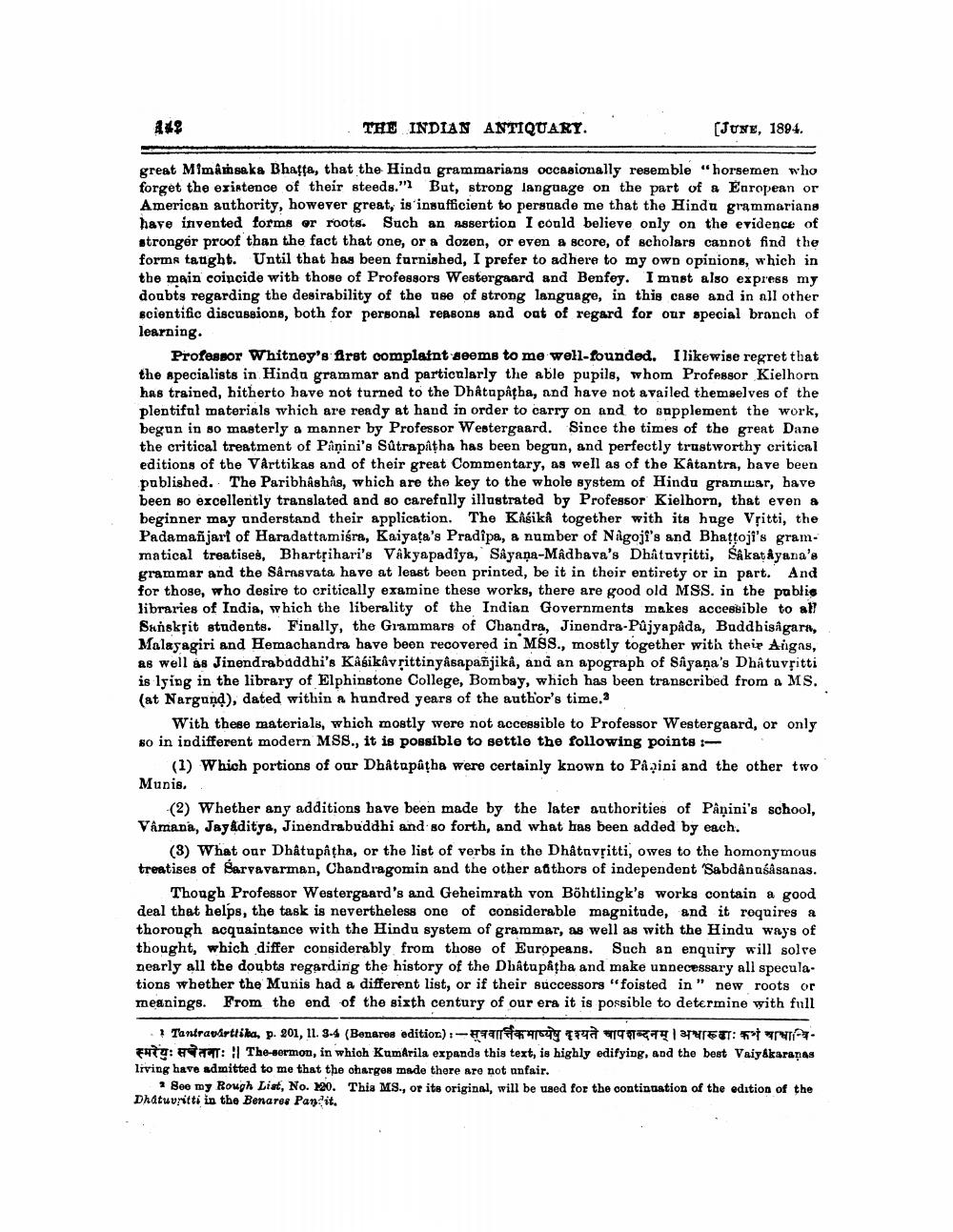________________
THE INDIAN ANTIQUARY.
(JUNE, 1894.
great Mimamsaka Bhatta, that the Hinda grammarians occasionally resemble "horsemen who forget the existence of their steeds." But, strong language on the part of a European or American authority, however great, is insufficient to persuade me that the Hindu grammariana have invented forms or roots. Such an assertion I could believe only on the evidence of stronger proof than the fact that one, or a dozen, or even a score, of scholars cannot find the forms taught. Until that has been furnished, I prefer to adhere to my own opinions, which in the main coincide with those of Professors Westergaard and Benfey. I must also express my doubts regarding the desirability of the use of strong language, in this case and in all other scientific discussions, both for personal reasons and oat of regard for our special branch of learning
Professor Whitney's fret complaint seems to me well-founded. I likewise regret that the specialists in Hinda grammar and particularly the able pupils, whom Professor Kielhorn has trained, hitherto have not turned to the Dhậtupåtha, and have not availed themselves of the plentiful materials which are ready at hand in order to carry on and to supplement the work, begun in so masterly a manner by Professor Westergaard. Since the times of the great Dane the critical treatment of Paņini's Sutrapatha has been began, and perfectly trustworthy critical editions of the Vårttikas and of their great Commentary, as well as of the Kåtantra, have been pablished. The Paribhashas, which are the key to the whole system of Hindu grammar, bave been so excellently translated and so carefully illustrated by Professor Kielhorn, that even a beginner may understand their application. The Kasika together with its huge Vșitti, the Padamañjart of Haradattamiśra, Kaiyata's Pradipa, a number of Någoji's and Bhattoji's grammatical treatises, Bhartsihari's Vakyapadiya, Sayaņa-Madhava's Dhîtavșitti, Sakatåyana's grammar and the Sarasvata have at least been printed, be it in their entirety or in part. And for those, who desire to critically examine these works, there are good old MSS. in the pablie libraries of India, which the liberality of the Indian Governments makes accessible to all Sanskrit students. Finally, the Grammars of Chandra, Jinendra-Pujya pada, Buddhisågarn, Malayagiri and Hemachandra have been recovered in MSS., mostly together with theip Argas, as well as Jinendrabaddhi's Kasikivsittinyåsapañjikâ, and an apograph of Sayaņa's Dhậtuvritti is lying in the library of Elphinstone College, Bombay, which has been transcribed from a MS. (at Nargund), dated within a hundred years of the author's time.3
With these materials, which mostly were not accessible to Professor Westergaard, or only so in indifferent modern MSS., it is possible to settle the following points :
(1) Which portions of our Dhậtapâţha were certainly known to Påşini and the other two Munis.
(2) Whether any additions have been made by the later authorities of Pâņini's school, Vámana, Jayaditya, Jinendrabuddhi and so forth, and what has been added by each.
(3) What our Dhâtupåtha, or the list of verbs in the Dhậtavritti, owes to the homonymous treatises of Sarvavarman, Chandragomin and the other at thors of independent Sabdanaśâsanas.
Though Professor Westergaard's and Geheimrath von Böhtlingk's works contain a good deal that helps, the task is nevertheless one of considerable magnitude, and it requires a thorough acquaintance with the Hindu system of grammar, as well as with the Hindu ways of thought, which differ considerably from those of Europeans. Such an enquiry will solve nearly all the doubts regarding the history of the Dbátupåtha and make unnecessary all speculations whether the Munis had a different list, or if their successors "foisted in " new roots or meanings. From the end of the sixth century of our era it is possible to determine with full
.? Tantrapirttika, p. 201, 11. 3-4 (Benares edition):- 1 41649
T
R IVETT: VA F y: : :| The-sermon, in which KumArila expands this text, is highly edifying, and the best Vaiyákaranas Irving have admitted to me that the charges made there are not anfair.
2 Boe my Rough List, No. 120. Thia MS., or its original, will be used for the continuation of the edition of the Dhatuvritti in the Benares Pandit.




